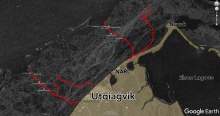Update
Sarah will be heading out to the North Slope in 2022. Stay tuned!
What Are They Doing?
 Land-fast sea ice is fastened along the shoreline in Utqiaġvik, Alaska. Photo by John Wood.
Land-fast sea ice is fastened along the shoreline in Utqiaġvik, Alaska. Photo by John Wood.
The participants of the International Arctic Buoy Program (IABP) work together to maintain a network of drifting buoys in the Arctic Ocean to provide meteorological and oceanographic data for real-time operational requirements and research purposes including support to the World Climate Research Programme (WCRP) and the World Weather Watch (WWW) Programme. Data from the IABP have many uses. For example: 1. Research in Arctic climate and climate change, 2. Forecasting weather and ice conditions, 3. Validation of satellites, 4. Forcing, validation and assimilation into numerical climate models, and 5. Tracking the source and fate of samples taken from the ice. Over 1000 publications have benefited from observations from the IABP.
Sarah and the team will be headed out for a second deployment to Greenland in June-July 2020.
Where Are They?
 Bowhead whale skulls near the college entrance in Utqiaġvik, Alaska. Photo by Melissa Lau.
Bowhead whale skulls near the college entrance in Utqiaġvik, Alaska. Photo by Melissa Lau.
The team will fly by commercial airline to Utqiaġvik (formerly Barrow), Alaska. While in Utqiaġvik, they will travel around by snow machine along the sea ice to deploy the buoys.
Latest Journals

John Woods is a native of Lavallette, NJ and currently resides in Annapolis, MD with his wife and 3 kids. He studied Oceanography at the United States Naval Academy and obtained his master’s degree in Oceanography and Meteorology at the Naval Postgraduate School in Monterey, CA. John served on active duty in the U.S. Navy as a Surface Warfare Officer on the USS Cleveland (LPD-7) deploying to the Persian Gulf two times, and as a Meteorology and Oceanography (METOC) Officer at the U.S. Naval Ice Center. His final tour was back at the U.S. Naval Academy teaching in the Oceanography Department where he created the Polar Science Program. This assignment first introduced him to Polar Operations and Logistics leading 4 different learning activities to the Arctic Region. After transitioning to the Navy Reserves, he was the Project Manager for NASA's Operation IceBridge, successfully executing over a dozen science campaigns to both the Polar North and South. Most recently John was a physical scientist for NOAA at the U.S. National Ice Center until recently transitioning back to the Navy in his current position with the Office of Naval Research, International Engagement Office focusing on collaborations with polar nations.

IGNATIUS RIGOR, Ph.D., is a climatologist at the Polar Science Center, Applied Physics Laboratory (APL), and an affiliate assistant professor in the School of Oceanography at the University of Washington (UW) in Seattle. Dr. Rigor studies sea ice, and how it interacts with the atmosphere and ocean. His primary tools for research are observations from drifting buoys and satellites.





